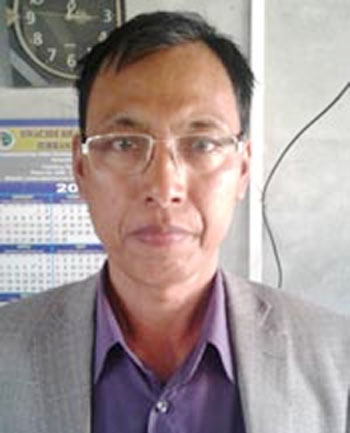SAWLAKIA : THE TRIBAL FOLK DANCE OF THE MARAS Prof. Dr K. Zohra. Government Siaha College Siaha, Mizoram 796901 The Sawlakia, which means , ‘The dance of the spirit of the slain’ was a war-like dance performed over the heads of the slain killed in the war. It was usually performed only at the Ia ceremony. The warriors danced the Sawlakia round the heads to please the evil spirit of the slain for total subjugation and transfer of the soul substance of the slain to the slayer when the latter died. The Sawlakia dance was mild and enjoyable accompanied with the regular beats of the different GONGS(Dawkho), Viadaw, and Baotla. It was simple, customarily performed by the warriors who brought the triumphant trophy, marching around the head in a circle movement. Capt. Lewin described it as “a stage to triumphal march”. The worrior or “Riapaw” who had taken the heads customarily led the dance, and he wore topical regalia, a plume called “Chhytlia” or “Rabo” in his hair. He held a ceremonial dao “Vaina” in his right hand, and other man dancers bore other different weapons, which were clanked together as the dancers moved. Spearman called “A wild sort of war-dance with Dhas and shields”. The Sawlakia Dance has Three steps: 1) Sawlakia 2) Chaochhipa 3) Dawlakia ORIGIN: Local elders says that the Sawlakia dance was performed first by the ‘Sizos’ of the Mara subgroup in honour of their first appointed chief MAHLIE – 1 of the Chozah clan, who belonged to the Thathla Chins. Then, he held the post of the Village Chieftainship, and occupied his big house “Opi” in the later part of the 15th Century A.D. Thereafter the dance became more popular among the Sizo sub-groups and other sub-groups of the Maras. It was originally danced only at the ‘Ia’ ceremony, and later it was also performed at “Opichho” ceremony. The local elders and scholars believed that the Sawlakia was originated from the head-hunting practice which was traditionally practiced by the early Maras since the time immemorial. It is however, difficult to give the chronological date of the origin of the Sawlakia and the practice of the head-hunting. Regarding the origin of the Sawlakia dance, there is a legendary story, which says that long ago while the Maras were living in the south Thlatla of the Chin Hills, the Tiger-men known as Hraila were frequently hunting men in the village forest, and spare no one who left outside the village fence. The villagers remained in the village for many days to save their life from the Tiger-men. One day, the chief’s wife sent one of her female slaves forcibly to collect firewood in the villge forest. The slave women went out alone at last, she reached a spot known as Teisaiby, where she met the Tiger-men. The Tiger-men performed a sort of dance, and tha girl then by imitation learnt such dance. After going back home, she narrated the whole incidence and started performed the dance. The Sawlakia was the most primitive Folk-dance among the early Maras, handed down from generation to generation since the time immemorial. The Sawlakia was originally a simple war-like dance, but gradually developed through many generations by making remarkable improvement in its significance from time to time. Later, it was improved and enriched by the development of Burman civilization, which brought about civilized goods like Gongs, Swords, Ceremonial Dao, etc.., which made the dance more enjoyable and beautiful. References: 1. Hlychho Mylai : Mara History, ( Mara version) LLM Press, Saikao, 1962 2. Hlychho Pachi : Mara Folk Dance And Song, ( Mara version) Spectrum Publication Guwahati, 1992 3. Lewin T.H :Wild Race Of South Eastern India, Firma KLM(Pvt) Ltd. Calcutta-12, Reprint, 1978 4. Lorrain, R.A. Rev. : Five years in unknown Jungle for god and empire, Lakher Pioneer mission, London, 1912 5. Parry, N.E : The Lakhers Firma KLM Pvt. Ltd. Calcutta, Reprint, 1976 6. Spearman, H.R : British Burma Gazetteer, volume II, Rangoon, 1880 7. Zohra, Dr. K : The Maras of The Mizoram: A Study of their History and culture, unpublished thesis, Guwahati University, 1994 8. Zohra, Dr. K : The Maras : Their Indegenous Tribal Traditions And Folk-Culture, unpublished manuscript, pp.22 |
